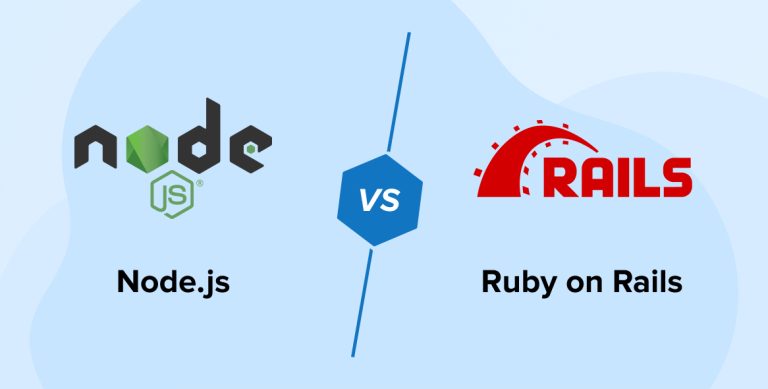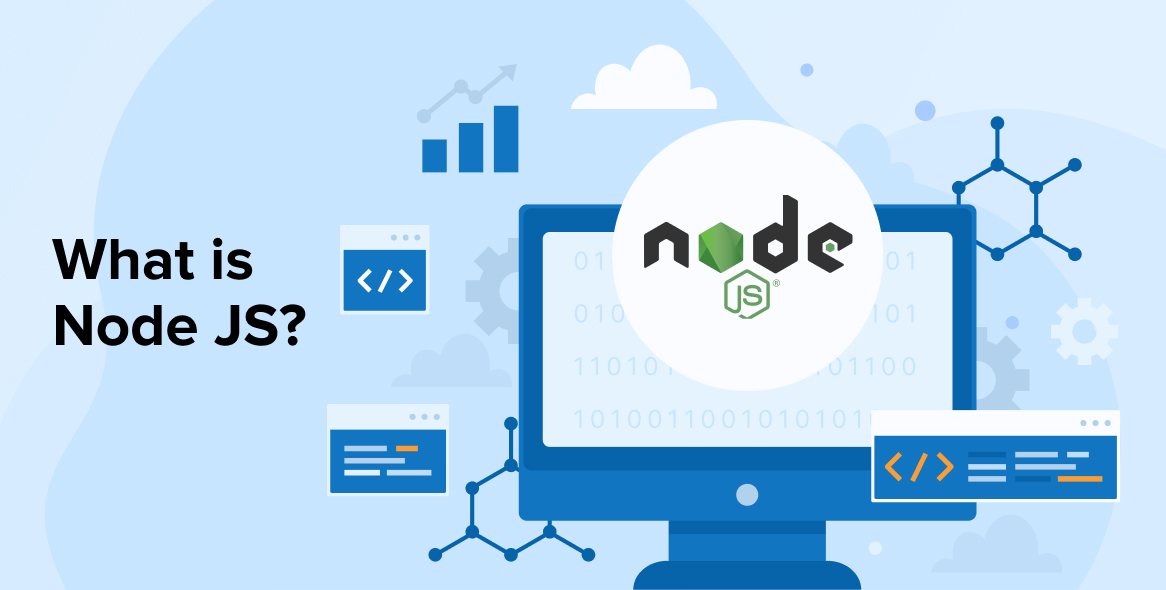
With the evolution of technologies, new web development tools and frameworks are appearing on the market. However, too many choices might result in confusion and uncertainties. When working in a subject as dynamic as web development, rapid and excellent outcomes are essential.
Node JS and Ruby on Rails are two well-known web solutions that can enable you to streamline your backend development workflow and obtain speedy, trouble-free outcomes. However, which backend technology should be used?
Before you hire any RoR or Nodejs development company, read this comparative guide on Node vs Ruby on Rails to help you decide the appropriate framework for your project. Willing to investigate further on Node JS vs Ruby on Rails? Let’s start with their introduction, pros and cons.
1. What is Node.js?
Node.js is a huge open-source server-side runtime environment built with Javascript. It claims its reputation as a strong, scalable and adaptable framework to the usage of a single-threaded web load mechanism and async development. In addition, you may leverage Nodejs-based frameworks like Express, Socket.io, and Meteor.js under it to improve a program’s backend functionality. The same language can be used to create single-page applications, webpages, web applications, and backend API services. It is developed with real-time and push-based infrastructures.
1.1 The Advantages of Node JS
1. Server-side Development
Node is effective in creating trustworthy connectivity between the web servers and the browsers. It employs a long-polling approach that enables programs to run through the development process maintaining numerous user traffic concurrently. NodeJS does not wait for every incoming request to be handled before tackling multiple requests.
This helps to make Node suitable for real-time apps such as instant messaging, online gaming, real-time collaboration tools, and chat apps. It provides efficiency, helps in computing resources and handles files with the help of modules. The ability to use JavaScript in both the frontend and backend will expedite the development time and simplify the development process. If you have experience with JS, understanding Nodejs for the server-side will not be difficult.
2. API Development
Node is the language of choice for developing REST APIs. Representational State Transfer is the meaning of the abbreviation REST. It is a system that lets consumers swiftly receive responses to their online queries. The fundamental concepts of REST development include uniformity, statelessness, client-server design, layering, cacheability, and on-demand response.
REST APIs are extremely useful for web development. Whenever a user searches for anything, a web application utilizes REST API to return source responses. REST APIs link the user’s data to the app’s code, establishing a channel of communication. With its rapid request handling speed and JS technology stack, Node.js is a logical fit for REST API development.
3. Microservices
The design of NodeJS is a wonderful match for the organization of microservices. Its event-driven methodology and non-blocking request processing technologies help you to link several services and simultaneously handle dozens of inside requests. Microservices must interact constantly; thus, ensuring rapid data processing is very crucial.
Node.js and microservice architecture both prioritize speed and efficiency. The purpose of a microservice architecture is to enable programmers to design flexible and high-performing systems by decomposing functions into controllable services. It’s V8 engine and non-blocking processing enable bringing it to existence.
1.2 The Disadvantages of Node.js
NodeJS is not yet a flawless backend framework. JavaScript is still a front-end technology that has not been converted to some server-side programming elements. It was not intended for backend functions. It must compensate for JS’s incapacity to run on the server, and as a consequence, the experience is rather constrained. Here are the reasons why.
1. Processor Consuming Tasks for Node.js Applications
Node.js is a single-threaded programming language, meaning it will only handle one query at a time until you create a sequence of events. It conducts actions rapidly when they are considered to be rapid. Nevertheless, when time-consuming operations are involved, Node does not regard it as an occurrence. A single long-term procedure will prevent all others from occurring.
Clearly, such a strategy results in considerable CPU usage (due to CPU intensive requests) and a significant slowdown. Therefore, many Node JS benefits are applicable so long as the application is not overloaded with resource-intensive operations. When the single processor core of Node is exceeded beyond its threshold, Node JS sacrifices a number of its advantages.
2. Security Concerns are Challenging to Address
Node.js is recognized for its extensive environment. The open-source package management system provides programmers with good code quality, extensions, and add-ons that may be reused, boosting the software’s adaptability.
Node is loaded with node package manager; utilizing ready-made modules saves a lot of time and may enhance code quality. Unfortunately, not all teams comprehend the risks posed by NPM packages. The trouble is that the Node.js team began screening modules for safety concerns very lately. A large number of existing npm packages, including tough-cookie, js.dom, and many others, contain complexity, weaknesses, and significant security risks.
1.3 Companies Using Node
1. NASA: NASA stated that Node makes it simple to migrate data from traditional records to cloud storage. It generated unified database environments for all queries and drastically decreased access time by 300%.
2. Twitter: Twitter Lite has a 30% quicker launching time and speedy processing on poor connections.
3. Netflix: Netflix has lowered processing times and enhanced performance dramatically. The migration of their backend from Java to Node JS reduced the launching time from 40 minutes to 60 seconds.
4. Trello: Trello has introduced instantaneous update propagation. As the application arranges work in an agile manner, they desire a solution that highlights changes without requiring a page reset.
2. What is Ruby on Rails?
Ruby on Rails, sometimes referred to as Rails or RoR, is a Ruby-based framework for developing server-side web applications. David Heinemeier Hanson brought it to the audience for the first time in 2004. The framework is one of the finest available solutions for novices to construct and launch fully-functional complex apps and websites.
RoR is a command-line platform that facilitates the execution of the same JS code written for the front-end. It enables code sharing between the backend and browser and the concurrent execution of several activities. Let’s examine how these benefits apply to various elements of web app development.
2.1 The Advantages of Ruby on Rails
Ruby programming language serves as a website development framework for backend. It is renowned for its productivity and adaptability. You can create robust features with fewer lines of programming than you would require in Java or Node.js.
1. Full-stack Web Application
Ruby on Rails is an extremely organized web development framework. Rails has several requirements around how the program must be arranged. The Model, View, and Controller structure is utilized. For an application to react to a query, a view, controller, and route must be defined. Starting with an MVC framework takes effort, but the resulting code optimization is tidy and simple to understand. To conclude, one will have a program code that is simple to manage and modify.
2. Content Management Systems
Ruby on Rails may not be the most common option for constructing content management systems at present. PHP continues to be the dominant option, but Ruby on Rails has lately joined the market and provides several competitive benefits. Due to its high abstraction data layer, Ruby on Rails enables the rapid development of complex features. You may map whole database tables as distinct objects. You can refer to a substantial portion of functions with a few lines of coding.
3. Prototyping
Ruby on Rails enables rapid coding and the implementation of available built-in functionalities. When developing the least workable variant of a product, performance and usability are of secondary importance compared to operational excellence and tidy development procedures. Numerous command-line code generators are available for Ruby on Rails, allowing ROR developers to skip creating code from the beginning. With the addition of open source libraries, this fully prepared asynchronous code can support more than 50% of operability.
2.2 The Disadvantages of Ruby on Rails
Considering how profitable it is to write in Ruby and Ruby on Rails, programmers often wonder why this tech stack and its framework are not more widespread. Well, despite the language’s undeniable economic advantage, its operational rating is not exactly great.
1. Performance Speed
In a performance comparison of Node vs Ruby on Rails, even seasoned Ruby on Rails programmers admit that the framework is sluggish. Although its speed increases with each new iteration, it is still much slower than Node’s and avoided in the case of rapid application development. There are several causes for the lag in performance.
Ruby is an interpreted programming language, which implies that its source code is not translated into a computer form. Thus, it is more difficult for hardware to rapidly grasp and interpret the text.
Node provides Just-In-Time translation, which converts JS code to bycode rather than a computer language. Eliminating an extra translation step improves the speed of the software. Ruby, in contrast, adopted JIT just in the latest releases, and it’s far from flawless – if anything, the present implementation of JIT decelerates code compilation.
Ruby allows for the creation of numerous threads. Therefore, the issue of handling CPU-intensive tasks is not as severe as it is with Node. Nevertheless, when assessing the speed of Node vs Ruby on Rails, Rails is not the superior option.
2. Garbage Collection Ineffectiveness
Generally, Garbage-collected programs are typically slower. Software developers may notice a dramatic rise in the computer memory utilization and a significant decrease in operational rate. The more you extend the program, the more RAM the garbage collector will need with each loop.
GC.disable will deactivate garbage collection in Ruby. There are other libraries for dealing with garbage-collector-related data breaches, although they serve mostly as a stopgap.
3. No Static Typing System
In this Node vs Ruby on Rails guide, Ruby’s lack of a static type system is one of its most visible shortcomings. TypeScript enables the integration of functionalities not originally offered by JS in NodeJS. These properties are produced and shown as JavaScript variables. The language does not differentiate between its native and non-native modules.
TypeScript is crucial for enhancing the quality of code, streamlining team interaction, and reporting work. Additionally, it permits the usage of specialized functions to optimize the app’s functionality with particular browsers. You are able to enter code, arrange features, and develop new features. These capabilities are not present in Ruby.
2.3 Companies Using RoR
1. Github: Github is a well-known website for personal and open software systems, with over 61 million directories for its 22 million users globally. Alongside Rail updates, they have been able to enhance speed, enhance documentation, and add functionality throughout the ages.
2. Basecamp: Basecamp is a well-known project management software and the first app to be created with Ruby on Rails. The truth is that they only allocate 15% of their money to RoR and says loudly about its cost-effectiveness.
3. Airbnb: Airbnb is a leisure app that links tourists and home managers in more than 220 nations and territories, with more than 5.6 million properties. They were able to decrease the TTM by utilizing the framework’s rapid development features.
4. SlideShare: SlideShare’s enormous 80 million customer base may share and watch slides submitted to the site, resulting in over 159 million site traffic. Using Ruby on Rails, they were able to expand to 3 million different users within their initial year without any problems.
5. Bloomberg: Bloomberg provides economic and commercial news to its very high monthly audience of 100 million visitors and earned a staggering $10 billion in 2018. With RoR’s development skills, they were able to immediately provide a highly straightforward user experience.
3. Node vs Ruby on Rails Comparison
Let’s start the Node vs Ruby on Rails comparison by covering different criteria for overall technology!
3.1 Performance
NodeJS
Node’s performance is among its greatest characteristics. The single-threaded, concurrent, and non-blocking operation of the JavaScript V8 engine has a significant impact on Node’s development speed. It is capable of handling multiple concurrent requests. Due to these fundamental properties of Node.js, the platform makes optimal use of a single CPU core and RAM.
Many businesses are incorporating NodeJS into the backend of their smartphone app stacks. PayPal, for instance, has increased the number of responses per second relative to its Java program. Additionally, PayPal reported a 35% drop in the mean response speed.
Ruby on Rails
Ruby on Rails, or more precisely Ruby (the language upon which Rails is built), is commonly perceived as a weaker technology than Node.js. There are several causes for Ruby’s subpar output.
Ruby’s Garbage collector (GC) employs a slower approach, causing the program to halt throughout garbage collection.
Classes and other primitive parameters consume a great deal of memory.
LinkedIn has observed a considerable decrease in speed while using Rails for string processing and JSON conversion. As a result of the company’s move to Node, the number of servers has been reduced from 30 to 3, and speed in some cases has increased by a factor of 20.
Nevertheless, this does not exclude Ruby on Rails as a backend technology. The programmers of Ruby aggressively fix any performance concerns. For instance, the much-expected Ruby 3 brought several speed enhancements such as concurrency and MJIT. Moreover, not all digital projects require the lightning-fast rates of Node.js. The determining factor is the number of visitors to be provided.
3.2 Microservices
NodeJS
Node and Microservices both provide relatively small services and code components. It is suited for the development of scalable applications since it efficiently manages several simultaneous requests/queries. Therefore, it is an ideal mix for developing enterprise-grade, scalable, complicated systems and complex apps.
Ruby on Rails
Ruby on Rails often favors monolithic design. However, this does not exclude its use in microservices infrastructure. Airbnb, for example, began with a monolithic design, but as the platform evolved, it became more difficult to maintain and deliver code. After migrating to a microservices architecture, the company was able to release 3,500 microservices every week with comfort. Therefore, Ruby on Rails can simply manage the requirements and releases of your microservices.
3.3 Learning Curve
Node
The learning curve is somewhat less steep than that of Rails. It is adaptable and straightforward for programmers with or without prior experience.
Ruby on Rails
Despite the fact that mastering Rails is simple, you may need to understand and comprehend the properties such as objects, classes, Ruby-level functions etc that are crucial and time-consuming to master so the learning curve of ruby is simple and easy.
3.4 Application Architecture
It is essential while selecting a framework to prioritize mobility and avoid rigid execution of design and principles. In reality, it is always advisable to see a framework as a guideline, not as a set of procedures and rules. In light of this, let’s compare Node.js with Ruby on Rails to see whether they are architecturally adaptable.
Node JS
Node.js utilizes the Single-threaded Event Loop design, which allows it to efficiently manage numerous parallel requests. Nevertheless, It also supports the MVC architecture/ MVP design paradigm, which simplifies isolating and addressing application codebase problems. Additionally, it permits concurrent communication between distinct modules and generates several outputs for the same data.
Ruby on Rails
Ruby on Rails adheres to the widespread MVC design (Model View Controllers). The model layer is when data manipulation rules and business logic are specified. The view is accountable for the software’s front end, while the controller manages the application’s flow.
Due to the architecture’s easy segregation of responsibilities, testing and decoupling at subsequent stages are simplified. Ruby on Rails likewise adheres to the notion of practice over configuration. It reduces developers’ workload because the framework has already made some decisions for them.
3.5 Community Support
Node JS
The NodeJS community is well-populated with great support. It has great community forums with 51.4% of experienced programmers, developers use Node.js for frameworks, libraries, and tools according to Stack Overflow Amazon, Facebook, and Google have made major efforts to the Node.js ecosystem, enhancing the credibility of the technology.
Ruby on Rails
The Ruby on Rails community is vast, experienced, and friendly. It has over 47,500 ratings and more than 4,000 collaborators on Github. In addition, they have a substantial presence on several community forums, including 154,000 users on Reddit and over 300,000 labeled queries on Stack Overflow. On Slack, there is a thriving community of 14,700 RoR aficionados. Additionally, there is a vibrant Gitter group with over 6,000 members discussing all aspects of the framework. In addition to this, there are several chat servers with thriving populations that follow Ruby on Rails-related concepts.
3.6 Hiring Developers
NodeJS
It is easy to employ Node engineers due to the big network of NodeJS engineers. In the northern United States, the typical range for employing Node.js engineers as professional or freelance workers is around $70 and $90 per hour, whereas, in Eastern Europe, the range is around $50 and $70 per hour. In Asian nations such as India, the hourly wage ranges from $20 to $40. With a few factors, including the portfolio and JavaScript basics, one must be ready to recruit the appropriate Node.js engineers for their developments.
Ruby on Rails
A huge Rails developers community allows you to employ Ruby on Rails engineers from a broad skill pool. It is debatable, but the mean salary of Rails engineers is $36 per hour. Salary can increase or decrease based on the project’s objectives and the developer’s level of expertise. This may not be easy to locate a good Rails developer, but you can locate one if you look in the proper places or work with the appropriate IT company.
3.7 Database support
NodeJS
NodeJS provides extensive support with all types of databases, including NoSQL and relational databases. Nevertheless, it is preferable to utilize a NoSQL database such as MongoDB since it saves information in JSON objects and makes it more accessible for JavaScript-based backends such as Node.js.
In reality, “mongoose” may be useful to handle data relationship management. The object data modeling framework is designed specifically for Node and MongoDB. In addition, it increases production by enhancing code readability, preserving code versatility, and modeling application data among other benefits.
Ruby on Rails
Ruby on Rails is preconfigured to work with SQLite. Nevertheless, Rails supports a multitude of alternative database management systems, including MySQL, PostgreSQL, Microsoft SQL Server, Oracle, and OpenBase. Furthermore, Rails permits the usage of numerous libraries so that you do not place all of your beans in one box.
3.8 Testing Support
Your software development project must undergo a set of tests to guarantee conformity with UI guidelines, interoperability, and usability in order to function flawlessly under constant, high load and increasing market requirements. Here is how Node vs Ruby on Rails contrast in terms of testing.
Node JS
With its vast runtime environment of third-party packages, Node delivers sufficient testing and debugging abilities. Several automated testing tools and technologies, such as Mocha, Jest, Lab and Code, Jasmine, AVA, form a robust testing environment for Node.js applications. In addition, you may utilize these testing libraries to provide your users with a smooth, bug-free journey.
Ruby on Rails
Testing is integral to Ruby on Rails, making it easy and efficient to do within the environment. As programmers write models and controllers, Rails generates skeleton test code naturally. This results in a substantial reduction in manual labor. In contrast, its concentration on excellent development techniques decreases testing phase complexities.
4. Conclusion
No second thought, the Node vs Ruby on Rails dispute is tough to resolve.
If you wish to develop a web application for streaming media or a single-page application with high performance and enhanced data computation power, CPU intensive applications or a multi-user, real-time online application as well as browser-based gaming applications, then NodeJS is for you without a doubt!
If you wish to create an eCommerce site with various advanced features or a social networking system/ expansive platform that can withstand high volumes of traffic or construct and deploy MVP affordably, then rails is all you need! With RoR, you may also develop a SaaS platform with several APIs and automations, informative systems capable of storing, managing, and delivering massive amounts of data to visitors, and a stock exchange platform that can easily handle massive volumes of changing data.
With this article, we presented you with all the sides of a coin. Now, the choice is yours!






This is a comprehensive and well-detailed comparison between Node.js and Ruby on Rails. Node.js is a good choice. If you're looking for a productive and easy-to-use framework for a complex application, then Ruby on Rails is a good choice.